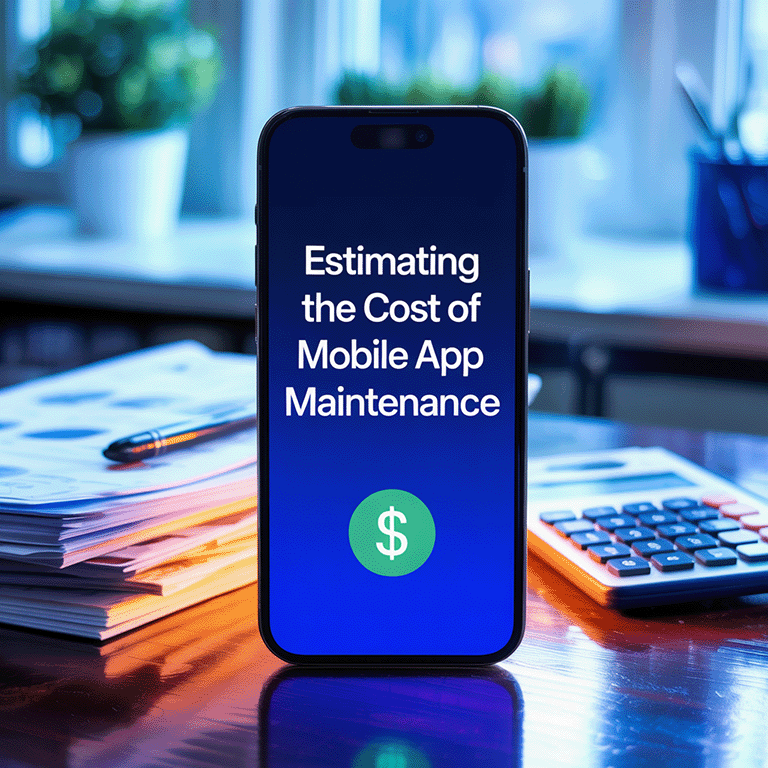In a world where AI handles all the tedious tasks that bog down your workday — scheduling meetings, generating reports, and more — you’re free to focus on the creative and strategic aspects of your job. This is the new reality of AI workflow automation.
Consider a busy marketing team: AI could automatically personalize email campaigns, analyze customer data to spot trends, and even draft social media posts based on predefined guidelines. This is just one example of how AI is revolutionizing workflows and boosting productivity to previously unimaginable levels.
This guide delves into the most popular AI trend — AI workflow automation — exploring its core components, its many benefits, and practical steps to implement it in your organization. Get ready to unlock AI’s potential and see your workflows transform into a symphony of efficiency and success.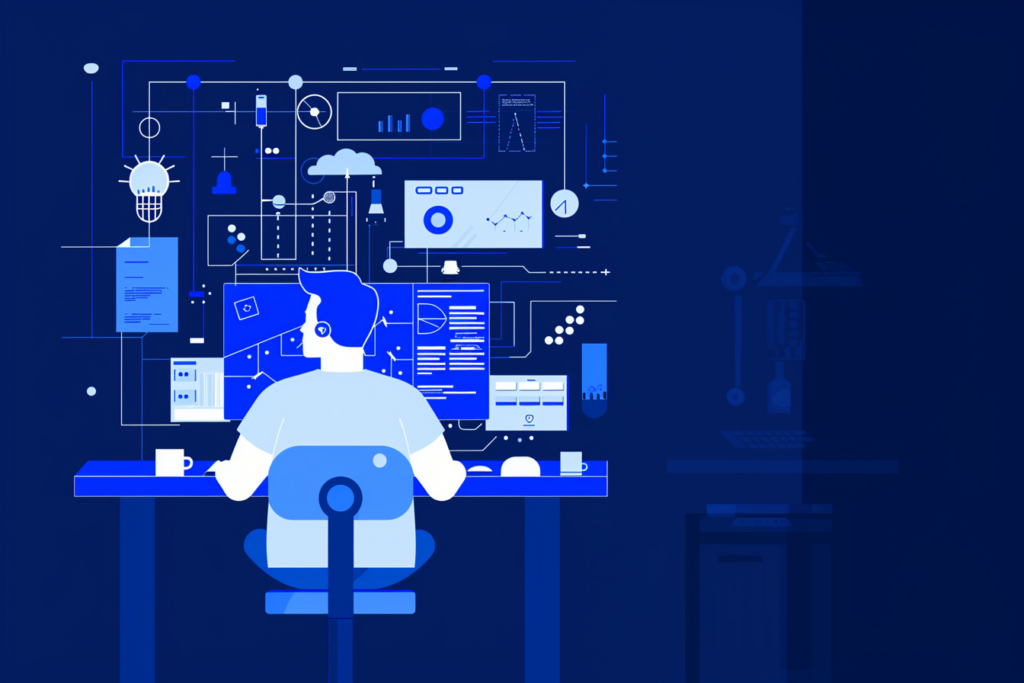
How Artificial Intelligence Streamlines Workflows
Artificial Intelligence (AI) plays a pivotal role in modernizing workflows by automating repetitive tasks and enhancing overall productivity. Here’s how AI effectively streamlines processes:
- Automates scheduling meetings, generating reports, processing invoices, and analyzing data.
- Improves efficiency and accuracy in task execution, reducing errors and operational costs.
- Frees up human workers to focus on creative, critical thinking, and decision-making tasks, enhancing job satisfaction and productivity.
- Drives innovation and competitive advantage in the market by enabling faster decision-making and strategy implementation.
Integrating AI into workflows empowers organizations to optimize resource utilization, achieve operational excellence, and stay ahead in an increasingly competitive landscape.
Why Automate Workflows with AI?
Here’s a breakdown of why AI workflow automation is a game-changer for your business:
| Benefit | Impact |
| Turbocharged Efficiency | Automates repetitive tasks, freeing employees for strategic thinking. |
| Error Eradicator | Minimizes human error, ensuring consistent and reliable data processing. |
| Data-Driven Decisions | Analyzes vast data sets to uncover hidden patterns and inform smarter choices. |
| Cost Cutter | Reduces labor costs and improves resource allocation, boosting your return on investment (ROI). |
| Scalability on Demand | Easily adapts to fluctuating workloads, making your operations future-proof. |
| Employee Engagement Enhancer | Frees employees from tedious tasks, leading to higher satisfaction and retention. |
AI Workflow Automation: A Step-by-Step Guide
The age of intelligent workflows is here! AI automation streamlines workflows, minimizes errors, and empowers your team to achieve more. This step-by-step guide equips you to harness AI’s power and transform your workflows.
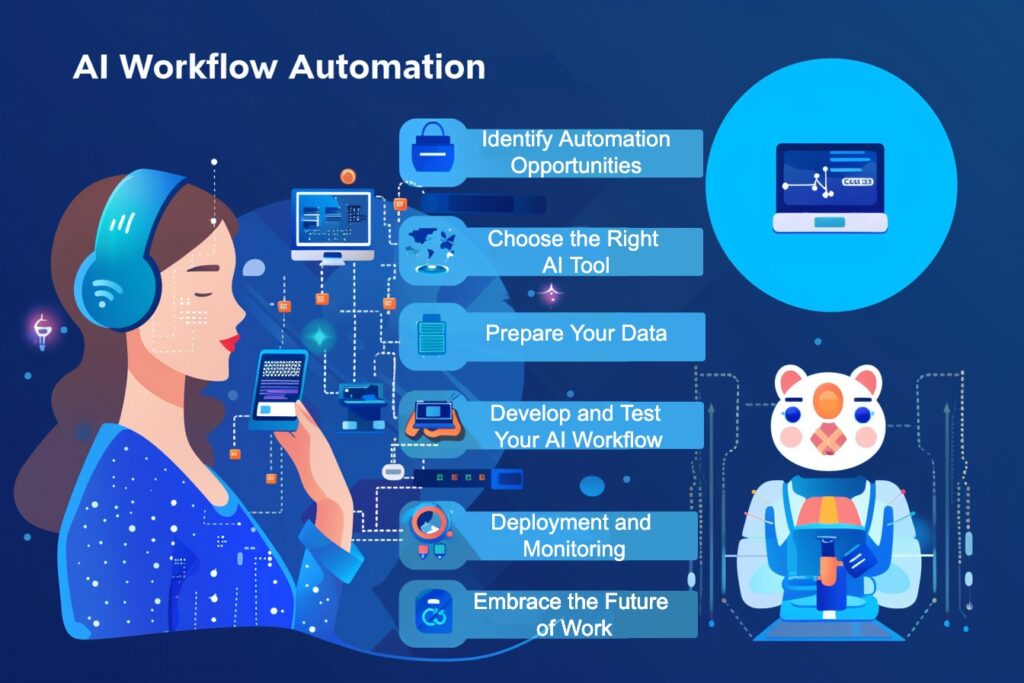
Step 1: Identify Automation Opportunities
- Map Your Workflows: Visualize your current workflows, pinpointing repetitive, time-consuming tasks. Analyze decision points and identify areas prone to human error.
- Prioritize for Impact: Focus on tasks with the most significant efficiency gains or error reduction potential. Consider tasks with high volume, consistency, and clear rules.
Step 2: Choose the Right AI Tool
- Consider Complexity: For simple, rule-based tasks, Robotic Process Automation (RPA) tools like UiPath or Blue Prism are a solid choice.
- Think Optimization: For complex workflows that require optimization, consider Intelligent Process Automation (IPA) platforms like Celonis or Krylon.
- Embrace Text Power: If your workflows involve text analysis (e.g., emails, documents), Natural Language Processing (NLP) tools like Amazon Comprehend or Google Cloud Natural Language API are your allies.
- Custom is King: For highly specific workflows, explore Machine Learning (ML) platforms like TensorFlow or PyTorch to build custom AI models. However, this requires technical expertise.
Still unsure? Here’s a quick tip:
- Start Simple: RPA tools are a great starting point for basic automation.
- Complex Workflows: Move towards IPA platforms for comprehensive solutions.
Step 3: Prepare Your Data
- Clean is King: Ensure your data is accurate, consistent, and well-organized. AI models rely on high-quality data for optimal performance.
- Labeling Might Be Necessary: For some AI models, you might need to label your data to train them to recognize specific patterns.
Step 4: Develop and Test Your AI Workflow
- Pilot Project Power: Start with a small-scale automation project to test your chosen tool and approach. This allows for adjustments and refinements before full-scale deployment.
- Build or Integrate: Build your custom ML model or integrate pre-built models from your chosen platform.
Step 5: Deployment and Monitoring
- Roll it Out!: Deploy your AI workflow across your organization, ensuring proper training and support for your team.
- Monitor and Optimize: Continuously monitor your AI workflow’s performance. Look for areas for improvement and fine-tune the AI model as needed.
Step 6: Embrace the Future of Work
You’ll be well on your way to unlocking the power of AI workflow automation. Get ready to experience a workplace transformed by efficiency, accuracy, and data-driven decision-making. Remember, this is just the beginning.
Real-World Wins: AI Workflow Automation Success Stories
AI workflow automation is a proven path to success for businesses across industries. Here are four examples showcasing actual companies reaping the benefits:
UiPath and Melia: Streamlined Guest Experience
- Challenge: Melia faced inefficiencies in handling guest service requests, leading to delays and guest frustration.
- AI Solution: Melia partnered with UiPath to automate tasks like scheduling wake-up calls and resolving basic inquiries, freeing staff to focus on personalized guest interactions.
- Result: Significant reduction in service resolution times, happier guests, and improved customer satisfaction scores.
IBM Watson and Mayo Clinic: Faster, More Accurate Diagnoses
- Challenge: Mayo Clinic doctors struggled with the growing volume of medical data, making timely analysis and diagnosis difficult.
- AI Solution: Implementing IBM Watson, Mayo Clinic used AI to analyze patient data, medical literature, and clinical trials, identifying potential diagnoses and treatment options.
- Result: Faster, more informed decision-making by doctors, leading to better patient outcomes and earlier interventions.
Automation Anywhere and EY: Intelligent Tax Processing
- Challenge: EY faced a massive workload during tax season, with manual data entry and review being time-consuming and error-prone.
- AI Solution: Partnering with Automation Anywhere, EY automated data extraction from tax documents and error identification, allowing professionals to focus on complex tax planning and client consultations.
- Result: Reduced processing time and minimized errors, improving service delivery and client satisfaction.
Google Cloud and Societe Generale: Personalized Wealth Management
- Challenge: Societe Generale wanted to personalize wealth management services for high-net-worth clients but was limited by manual data analysis.
- AI Solution: Using Google Cloud’s AI platform, Societe Generale analyzed client financial data, market trends, and risk tolerance to generate personalized investment recommendations.
- Result: Enhanced wealth management services, leading to increased client satisfaction and improved asset retention.
Challenges and Solutions: Navigating the Road to AI-Powered Workflows
While AI workflow automation offers many benefits, it also presents challenges. Here’s a guide to overcoming them:
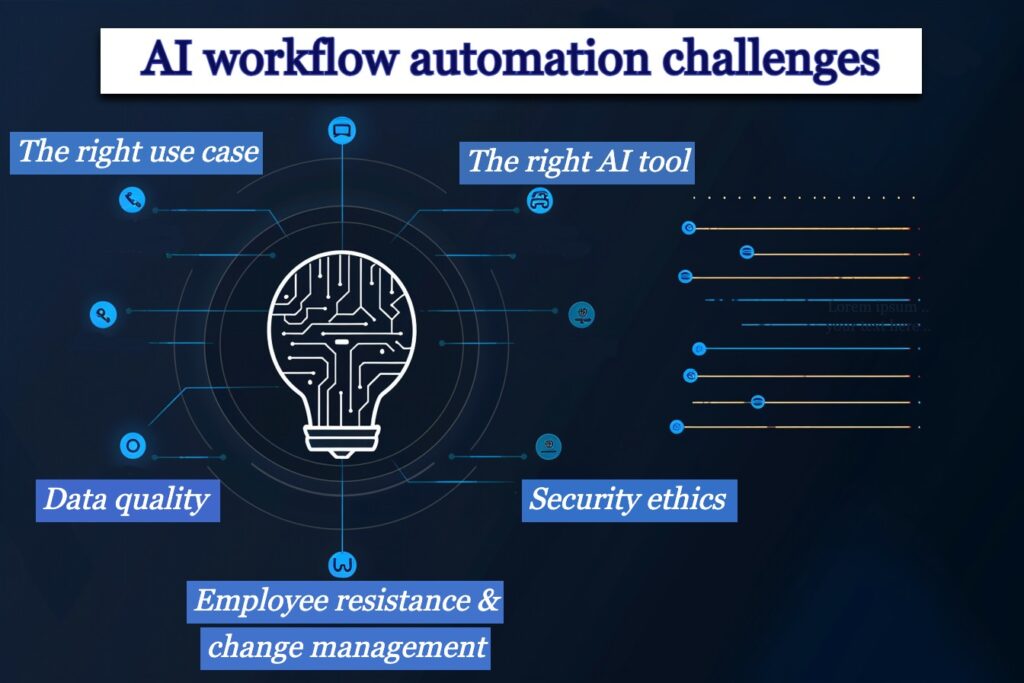
Challenge 1: Identifying the Right Use Case
- Issue: Automating unsuitable tasks wastes resources and has limited impact.
- Solution: Analyze workflows to identify repetitive, high-volume tasks with clear rules. Focus on areas prone to human error or bottlenecks.
Challenge 2: Choosing the Right AI Tool
- Issue: The wide variety of AI tools can be overwhelming, and the wrong choice can hinder performance.
- Solution: Assess your needs and technical expertise. Start with simple RPA tools for basic automation and progress to more advanced IPA platforms for complex tasks. Use NLP tools for text-heavy tasks and custom ML models for specific needs, noting that these require significant technical resources.
Challenge 3: Data Quality Concerns
- Issue: Poor quality data results in inaccurate and unreliable automation.
- Solution: Implement robust data cleansing processes to ensure data accuracy and consistency. Data labeling may be necessary to train AI models effectively.
Challenge 4: Employee Resistance and Change Management
- Issue: Employees may fear job loss or struggle to adapt to new workflows, which can impede AI implementation.
- Solution: Promote transparency and open communication. Involve employees in the automation process and provide training to prepare them for their evolving roles. Emphasize how AI complements their work, allowing them to focus on higher-value tasks.
Challenge 5: Security and Ethical Considerations
- Issue: AI workflows handle sensitive data, and security breaches or biased algorithms can have serious consequences.
- Solution: Implement robust security measures to protect data privacy. Evaluate AI models for potential biases and ensure they align with ethical guidelines.
The Perfect Match: Choosing the Right Partner for AI Workflow Automation
Embarking on AI workflow automation is an exciting adventure, but navigating the complexities of AI tools and ensuring a smooth transition can feel daunting. That’s where the right partner comes in — a trusted advisor who complements your expertise and guides you toward successful implementation. Here’s what to look for in your ideal AI workflow automation partner, with a focus on the strengths LITSLINK brings to the table:
Expertise and Experience:
Look for a partner with a proven track record in AI solutions and a deep understanding of your industry’s specific needs. They should possess the technical know-how to assess your workflows, recommend the right AI tools (including custom solutions!), and ensure seamless integration.
Focus on Business Value:
The best partners go beyond technology. They focus on the business value proposition of AI automation. They’ll work with you to identify workflows with the highest impact, analyze potential ROI, and develop a clear roadmap for achieving your business goals.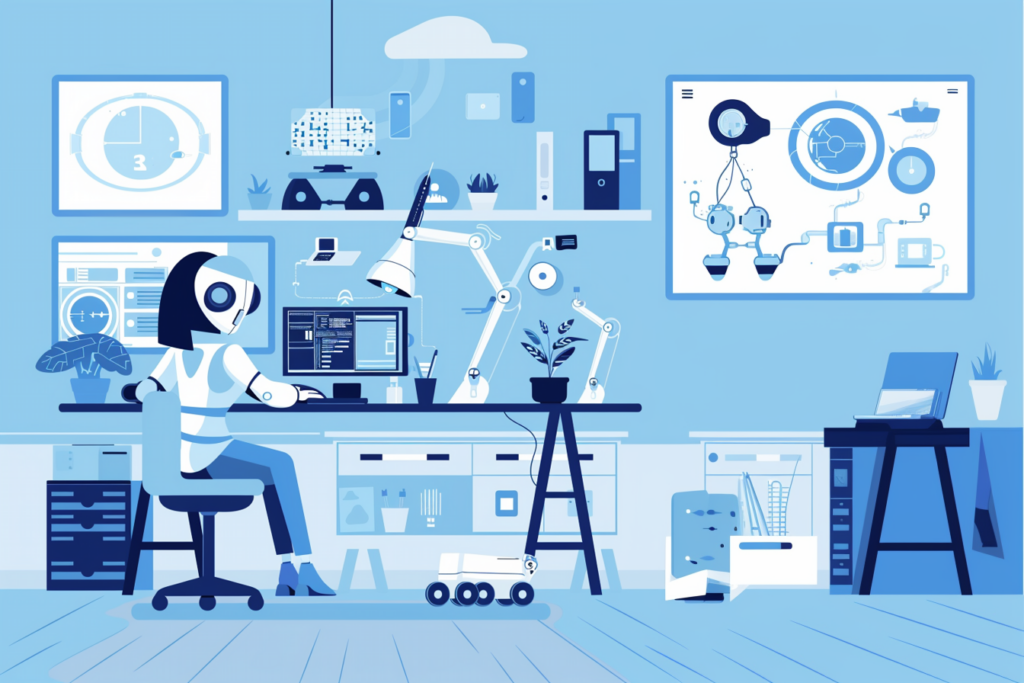
Scalability and Future-Proofing:
Your AI journey shouldn’t end with the initial implementation. A forward-thinking partner will consider scalability and future needs. They’ll choose AI tools (including custom-built solutions) that can grow with your business and adapt to evolving technologies.
Change Management Prowess:
AI implementation often involves process changes and employee training. The right partner possesses strong change management skills. They’ll help you navigate employee concerns, develop training programs, and ensure a smooth transition for your workforce.
Collaborative Spirit and Transparency:
Open communication and collaboration are crucial for success. Your partner should be transparent about costs, timelines, and potential challenges. They should actively engage with your team, fostering a collaborative environment where knowledge is shared and all voices are heard.
Data Security and Ethical Considerations:
AI workflows handle sensitive data. Your partner should prioritize data security and have robust measures in place to protect your information. Additionally, they should be well-versed in ethical considerations surrounding AI and ensure your chosen tools align with your company’s values.
Why Consider LITSLINK?
LITSLINK goes beyond being just another AI solution provider. We are a true partner, offering a comprehensive service that includes:
- In-depth Workflow Analysis: LITSLINK will meticulously analyze your workflows to identify the most suitable AI solutions for automation.
- Custom AI Development: Our team of experts can build custom AI models tailored to your specific needs and industry.
- Seamless Integration: LITSLINK ensures a smooth integration of AI tools into your existing infrastructure, minimizing disruption.
- Ongoing Support: We offer ongoing support and maintenance to ensure your AI workflows continue to operate efficiently.
Conclusion
AI workflow automation is transforming the way businesses operate, streamlining processes, and freeing up valuable human resources for more strategic tasks.
Embracing AI not only enhances efficiency and accuracy but also empowers employees to focus on innovative, high-value activities.
AI’s role in shaping the future of work will only grow, offering endless possibilities for increased productivity and business success.



